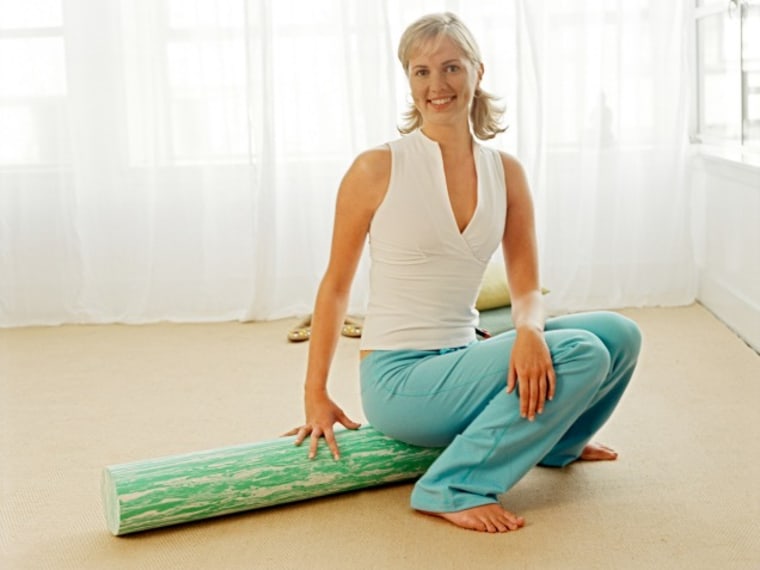Every time you see a fellow gym-goer lying on one of those long, black rolls on the floor you probably ask yourself, what it's all about. It's called foam rolling and it's starting to catch on.
“There's definitely been an influx of people starting to use [foam rollers], especially by people who are working out on a regular basis,” says Ryan DeWitt of DeWitt Physical Therapy in Santa Cruz, Calif.
Why should I try it?
The roller helps increase blood flow, which is a great way to self-massage those tight, overactive muscles and prepare the tissue for an intense workout. Stretching does that too, but foam rolling helps to "tenderize the muscle" so as you exercise, your muscles can achieve full range of motion, DeWitt says.
Another benefit? Foam rolling can “break up adhesions on the muscles, which are caused by micro tears to the muscle,” explains Chad Raynor, a certified personal trainer at Crunch Gym in New York City.
“Adhesions are almost like scabs on top of the muscle, but unlike the scabs on our skin that fall off, these adhesions stay on the muscle,” he says. “They make the muscle not work properly, which can cause compensations or imbalances.”
Think of the adhesions on your muscles like starch in a shirt. The more you move around in the shirt, the less stiff it gets, and the more comfortable it becomes to wear. Your muscles act in the same way. Regular rolling will increase your range of motion and flexibility. It might hurt the first few times you foam roll, but ultimately it brings relief to stiff, sore muscles.
The more you foam roll, the easier it gets, says Raynor.
How is it done?
Target the muscles that are giving you trouble. Let's say you have tight hamstrings. As you sit on the floor with straight legs, you would place a foam roller under the area of tightness—in this case the back of your thighs—and prop yourself up with your hands. Next, use your body weight to apply pressure as you slowly roll the device over the muscle. You'll know when you hit an adhesion because you'll feel discomfort. When that happens, hold the roll on that spot for 30-90 seconds so that the pressure has time to break up the adhesion, Raynor says.
What parts of my body should I use a foam roller on?
You can use it just about anywhere! In fact, it may be quicker to explain where you shouldn't use a foam roller. “I would avoid the groin area and any breast tissue, but you can probably adapt it to most other tissues in the body,” says DeWitt. Though he cautions that people with osteoporosis or other bone conditions prone to fracture should be careful over the long bones, like the femur and the spine.
When should I do it, and how often?
Whenever you can. Both DeWitt and Raynor prefer clients do it before exercise to lengthen overactive muscles from their everyday lifestyle (read: sitting at a desk all day), but post-workout is fine, too. “Now that all your tissues have worked and moved, you might look at it as a flushing technique,” DeWitt says. “Those muscles are now sore and there are a lot of metabolic waste products [like water and salt] that have added up, so if you roll following exercise, it will keep that stuff from just sitting around in your muscles.”
What should I look for in a foam roller?
There are two things to consider when shopping for a foam roller: length and firmness. “They come in either one-foot or three-foot sections,” DeWitt says. “One-foot is pretty small, it's good for doing stuff with your legs, but you can't really do anything with your spine on that. Make it firm enough so that it feels like you’re doing something, but not so firm that you don't want to ever get on it.” Raynor likes The Grid by Trigger Point. “When you foam roll, you want more pressure on the muscle so that you are able to get as deep into the tissue as needed to release the muscle from the adhesion,” he says. Such a foam roller will be more painful than other options, but he adds, “If you are rolling on a consistent basis, you will adjust quickly to the standard roll, and will need to upgrade anyway.” Still, if you want to ease into it, you can find grid-less foam rollers at any sports store or online retailer.
What's the biggest mistake of beginner foam rollers?
Rolling too fast! Only roll the muscle at about an inch per second so you can actually feel if you have any adhesions that need to be addressed, says Raynor. “If you were to get a massage, and the therapist just ran their hands up and down quickly with little pressure, I would assume you would not be happy with the final result,” he says. “If you are rolling back and forth too fast, you are defeating the main purpose of trying to break up the adhesion.” So approach foam rolling in the same way you would request a deep tissue massage and you'll finish feeling just as good.
A version of this story originally appeared on iVillage.
